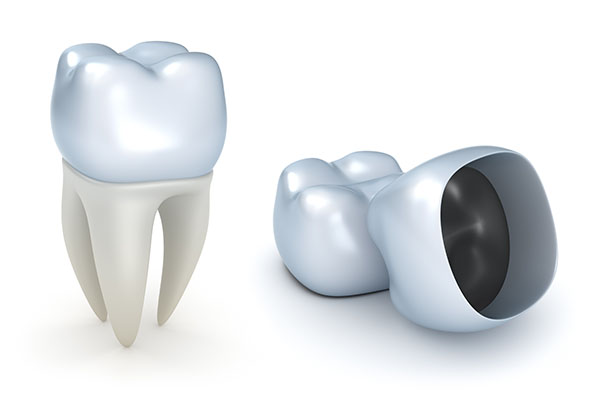 A dental crown is a versatile restoration that can be used to address a wide range of dental issues like a cracked, chipped, decayed, deformed, or broken tooth. The crown covers up the part of the tooth that is visible above the gums, protecting it from further damage and acids made by oral bacteria.
A dental crown is a versatile restoration that can be used to address a wide range of dental issues like a cracked, chipped, decayed, deformed, or broken tooth. The crown covers up the part of the tooth that is visible above the gums, protecting it from further damage and acids made by oral bacteria.
Treating a cracked tooth with a dental crown
The severity of a crack that forms on a tooth determines how the dentist recommends treating it. The visible part of a person’s tooth has multiple layers, such as the outer chamber called the enamel and the innermost layer called the pulp chamber. The pulp chamber contains the nerves and blood vessels that supply the tooth with nutrients. The middle layer of a tooth’s crown is called the dentin and it makes up most of the tooth.
A crack that only affects the enamel and dentin is classified as mild to moderate. A dentist might be able to address it with more affordable treatments like composite bonding. A crack that reaches the pulp chamber typically needs root canal therapy and a crown.
The dental crown process
A cracked tooth never heals on its own, it only widens and deepens over time, causing more damage to the tooth’s structures. Covering a tooth prevents acids in the mouth from getting into the crack and expanding it. It also protects the tooth so it does not fall apart due to bite forces inflicted by chewing.
If the damage to the tooth reaches the pulp chamber, the dentist might recommend a root canal to clean out the soft tissues there. A crack leaving the pulp chamber open means bacteria in the mouth can now reach the soft tissues there and infect them. A root canal helps to protect against such issues and a crown is placed on the tooth afterward to preserve and restore it.
Local anesthetics are typically used during root canals to prevent the patient from feeling pain. A dental drill is used to make a hole into the pulp chamber and files are used to pull out the soft tissues. Medication is applied to the area before the dentist seals it with a material called gutta-percha.
Other options
Minor cracks can sometimes be fixed with composite bonding and cracks that extend below the gumline typically cannot be fixed with a crown. Dentists often recommend extracting cracked teeth when the damage reaches their root. The extracted tooth can be replaced with an oral prosthetic like an implant. In some cases, the dentist might be able to install the implant right after extracting the damaged tooth.
Do you have a cracked tooth?
A cracked tooth is often accompanied by symptoms like toothaches and increased sensitivity. Getting the appropriate treatments brings the pain to an end and restores the function of the tooth. Call or visit our Peabody clinic to set up an appointment to learn more about how a crown can address your cracked tooth.
Request an appointment or call Northside Dental Care, PC at 978-206-7077 for an appointment in our Peabody office.
Recent Posts
Dental crowns are often costly and require that a dentist remove a significant amount of the tooth's structure to place them. Read on to learn about dental crown alternatives. Other treatment alternatives are sometimes available that are either less expensive or significantly less invasive. Dental crowns are frequently used to restore severely damaged teeth.The following…
A dental crown can restore a damaged, worn, or weakened tooth. This restoration can bring back your healthy smile and stable dental function. Knowing the benefits of dental caps can motivate you to set an appointment soon. Here are the benefits of a dental crown that you must consider.Losing a tooth can be annoying, especially…
A dental crown is a way for a dentist to repair a broken or damaged tooth. This is a simple solution that many people elect because it is durable and looks like normal teeth. It is also a great option if you have only one tooth that is damaged.The crown is made to match your…


